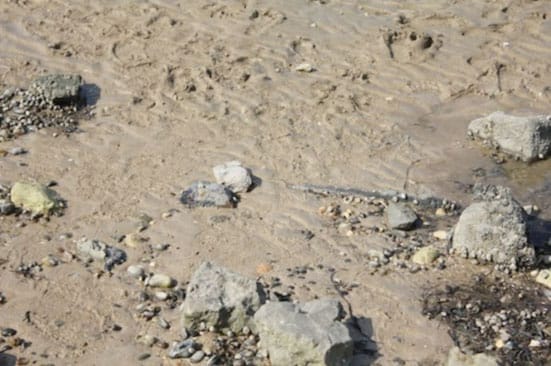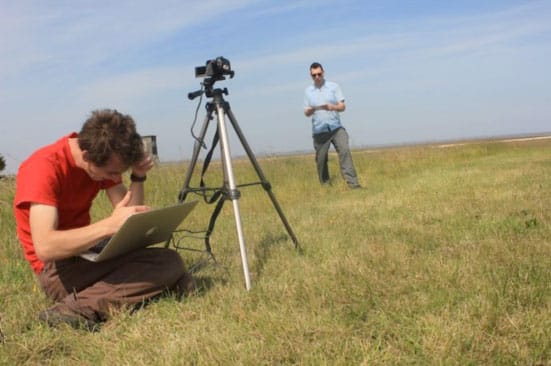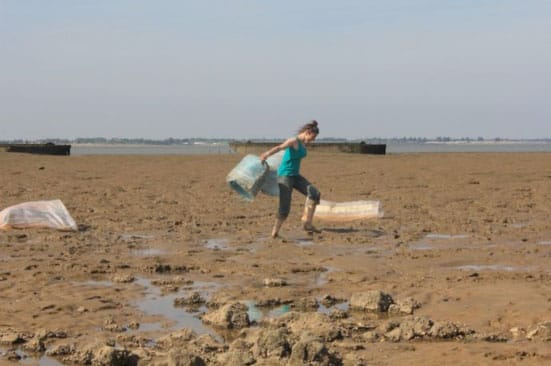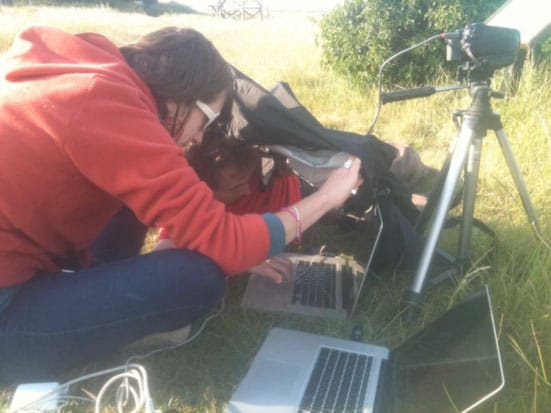Draw your foot across the vast brown crust of mud at Bradwell on sea and you reveal a rich sticky black mud. 5 minutes of obsessive foot sliding across it produces thick black streaks. You look down at your trainers, soaked and black. The kit list instructions given to participants included sensible shoes and sun cream but in your chaotic departure this morning you failed to bring either. You catch yourself smiling as you sit down on the dunes of white shells banked up between the mud and marsh – it feels good to be out of London. Time passes and your hands become covered in white dust from playing with the shells. They make a great sound. You spot Laura in the distance shaping a ball of black mud, patting it from one hand to another. Intermittently she crouches down to scoop mud from a hole that is emerging in the brown surface of an outcrop of mud. Adding this to the canon sized ball she begins the patting again. You discuss the mud and she shows you a ‘ball splat’ and says that she thinks she’ll use the mud ball in her broadcast. Adrian was looking through paint swatches in preparation for his broadcast when you left the picnic, talking pie charts with Rob. Out of site around the corner Sarah is barefooted chasing ribbon cylinders as the wind drives them across the mud flats. Laura heads back in the direction of the stone chapel with her mud ball. You are left staring at the hole it came out from.
On 14th June 2011 Field Broadcast took two car loads of London based artists on a fieldtrip to Bradwell-on-Sea. (In the cars: Rebecca Birch, Sarah Bowker-Jones, Fritha Jenkins, Adrian Lee, Rob Smith and Laura Wilson). Packed up with the artists were a picnic, laptops, cameras, battery pack and mobile dongles. Invited by the University of Derby to contribute to the blog and conference, Digital Hybridity – an examination of the effects that developing digital technologies are having on representation, modes of perception, criticism and the materiality of information – Field Trip was a way of exploring some of these issues whilst giving city based artists the opportunity to see what occurred when they spent the day together away from town making live broadcasts.
Whereas in the first Field Broadcast project artists sent broadcasts from their chosen location in their own time, Field Trip artists went out into the field together and entered into an immediate dialogue with the place of broadcast. By removing the potential for any substantial rehearsal or planning artists were free to allow the landscape and environment to play a more direct role in the creation of the work. The influence of the location is very present in the resulting Field Trip broadcasts.
Each live broadcast performed during Field Trip made a direct link between Bradwell-on-Sea and the audience. The performative elements within Field Broadcast extend to the application itself, which literally ‘pings’ to announce an incoming broadcast. With the ping a window pops up over whatever is open on your desktop at the time. The audience downloads an application to receive broadcasts but the exact times of them are not disclosed. Consequently as audience/receiver you are as likely to be eating your lunch, working on documents or away from the computer as you are to be prepared to experience an artwork when the pinger goes off. This makes for potentially rich and unusual encounters, re-actions and interactions with the work. The direct link between location and audience offered by the broadcast also demands a willingness by the viewer to leave open their individual desktop to allow the performance to act out an interruption in that particular space in its own time.
Rob Smith and Rebecca Birch support and collaborate with every artist in order to realise broadcasts and the nature of the project Field Trip facilitated extended collaborations. The driving of the artists to the site initiated a sharing en route of anecdotes, traffic jams, explanations, silence, and observations of the landscape between participants before Bradwell-on-Sea was encountered. Once at the site individual and group dialogues were opened up through direct engagement with the location. Artists participated in shared explorations and were present during each other’s broadcasts contributing to the energy of the live event. The day unfolded across the mud flats as an eloquent conversational piece, grounded in moments of connection and in a generous exchange of ideas, process and play.
See the Field Trip videos here: http://www.fieldbroadcast.org/projects/fieldtrip.html
From 21st July Field Broadcast brings Seven Sunsets to a desktop/field near you. To download the viewer visit www.fieldbroadcast.org
Field Broadcast is a live broadcasting network/ project/ platform/ contraption designed and developed by artists Rob Smith and Rebecca Birch. It enables artists to make artworks that forge a direct link between the place they are broadcasting from and their audience. The broadcasts are received live through a downloadable application allowing an event to be dispersed through the internet to a global audience. www.fieldbroadcast.org
Fritha Jenkins




